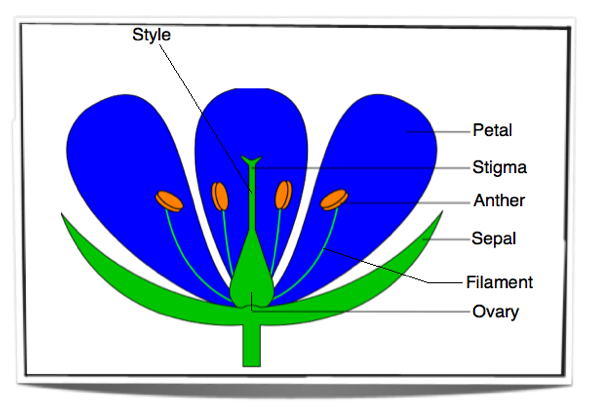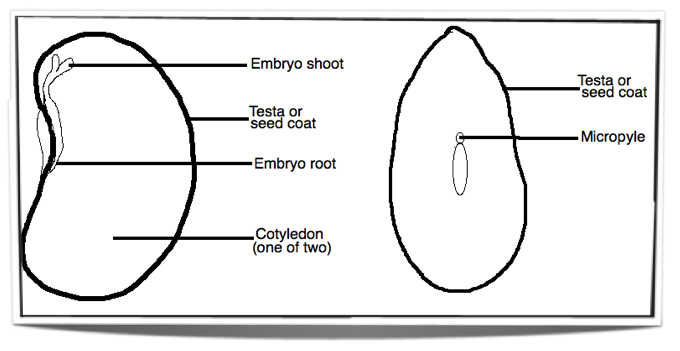Reproduction in angiospermophytes
9.3.1 Draw and label a diagram showing the structure of a dicotyledonous animal-pollinated flower.

9.3.1 - Structures of a dicotyledonous flower
9.3.2 Distinguish between pollination, fertilization and seed dispersal.
Pollination - The process of pollen transfer from an anther to a stigma.
Fertilization - The fusion of a male gamete with a female gamete inside the ovule. This forms a zygote.
Seed dispersal - The movement/transport of seeds away from the plant. Fruits which develop from fertilised ovules, function as a mean of seed dispersal.
9.3.3 Draw and label a diagram showing the external and internal structure of a named dicotyledonous seed.

Figure 9.3.2 - Phaseolus vulgaris seed internal (left) and external (right) structures
9.3.4 Explain the conditions needed for the germination of a typical seed.
Germination is the emerging and growth of an embryonic plant from a seed. It requires certain conditions, such as water, heat and oxygen. If conditions are not favourable then the seed may remain dormant. This way the seed can survive adverse conditions and only start to germinate when conditions become more favourable.
Water is needed to rehydrate the cells of the seed. This is vital for the activation of certain enzymes which start the metabolism of the seed. Without water the embryo root and shoot are not able to grow. Also water causes the seed to swell and this leads to the bursting of the seed coat which enables the plant to emerge from the seed. In addition, heat is needed for germination as the enzyme activity inside the seed depends on it. However, appropriate temperatures are needed. If it is too hot or too cold the enzyme activity will be too low for germination. Therefore, seeds usually remain dormant if heat conditions are not favourable. Finally, oxygen is needed for metabolism. It is used in aerobic cell respiration to provide the energy for the growth of the plant until the first leaves emerge. Once the leaves emerge, photosynthesis can then provide the energy needed for growth.
9.3.5 Outline the metabolic processes during germination of a starchy seed.
The absorption of water is followed by the formation of gibberellin in the embryo's cotyledon. This stimulates the production of amylase which catalyses the breakdown of starch into maltose. This maltose then diffuses to the embryo for energy release and growth.
9.3.6 Explain how flowering is controlled in long-day and short-day plants, including the role of phytochrome.
Flowering in long-day and short-day plants is controlled by a pigment called phytochrome. This pigment exists in two forms, Pr and Pfr, which can be converted into each other. The Prform is the inacctive form and absorbs red light with a wavelength of 660 nm. When Prabsorbs red light it is rappidly converted to the active Pfr form. The Pfr form absorbs far red light with a wavelength of 730 nm and then rapidly converts to the Pr form again in day light. However, normal day light contains more light of wavelength of 660 nm rather than 730 nm. This means that in normal day light, there is more Pfr than there is Pr. However the Pr form is the more stable of the two and therefore during the dark hours Pfr is slowly converted back into Pr. The amount of Pfr remaining after the dark nights is most likely the way plants can time the legth of dark periods. If the dark period is short, this means there will be a lot of Pfr as not much of it will have converted back into Pr. If the dark period is long, less Pfr will be available as most of it will have been converted back into Pr. Furthermore, Pfr promotes flowering in long day plants and inhibits flowering in short-day plants. Therfore, during long dark periods (autumn-winter) short day plants will flower as most of the Pfr has been converted back into Pr in the morning. On the other hand, long-day plants flower in the shorter dark periods (spring-summer) as enough Pfr remains in the morning to promote flowering.
